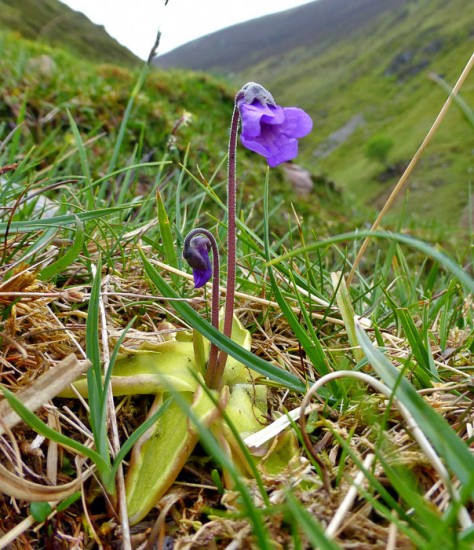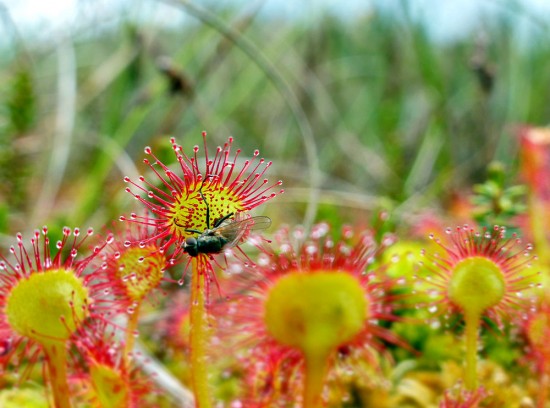
It certainly looked like an animal what with its ten enormous red mouths, fringed with dagger-like teeth. They’d sit there, motionless and open, waiting for flies to land on them before snapping shut.
I was never lucky enough to see Venus trap a fly, and because I’d never seen the traps close I used to tickle its mouths, trying to fool it into doing so.
It didn’t always work. Venus didn’t always want to perform. Sometimes it didn’t matter how much I tickled it or what I dropped into its open jaws, it just didn’t want to snap shut.
Truth be told my touch was too heavy and Venus knew full well that the offerings I brought weren’t things it could eat. It wasn’t going to expend precious energy and resources trying to digest a Lego man’s head. Otherwise it mightn’t have any mouths open when something genuine and juicy came along.
Nevertheless, despite its diva-like refusal to perform on demand, it kindled a fascination in carnivorous plants that never left me.
For the longest while it was a fascination that could only ever be fed by a steady diet of David Attenborough TV programmes such as The Private Life of Plants, for these strange creatures tended to reside in the kinds of places I’d be unlikely to visit.
Outrageously hot, humid places where every other creature can bite, sting, scare or infect you. Not the kinds of places this temperate cold loving individual would enjoy, and so I resigned myself to never likely seeing a carnivorous plant in the wild.
So, imagine my surprise and delight, much later in life, when someone told me that we have carnivorous plants here in the British Isles. I instantly went to seek them out….
Carnivorous plants in Scotland
A plant is considered carnivorous if it lures, traps, kills and digests its prey, and we have a dozen or so species in Great Britain that do this.
They’re split across three main groups (or genera…which is the plural of genus). Utricularia, Pinguicula and Drosera, or to give them their respective common names we have Bladderworts, Butterworts and Sundews.
Not all of the British species are found in Scotland but we do have all three of the groups represented. The ones I’m focusing on here are the two that you’re most likely to see whilst out & about in the hills: butterworts and sundews.
Bladderworts are aquatic rather than terrestrial plants so tend not to be encountered to the same extent.

Common Butterwort, The Gaick, May 2014
Butterwort
Of all the carnivorous species found in Scotland, Pinguicula vulgaris, or Common Butterwort is the one you’re most likely to see.
That’s chiefly because of its odd appearance when seen from above, when its star-like clump of lime-green, yellowy leaves stand out against the dark peat or vegetation. In summer it flowers quite beautifully on a long stalk with a purple flower, and even at a modest 5 to 10cm tall it can be hard to miss.
Also known as bog violet, it’s an alien-looking plant quite unlike anything else you’re likely to encounter during a day in the hills.
Sundew
From the same family as the Venus Fly Trap, there are over 150 species of sundew worldwide. Scotland has three but the one you’re most likely to see is Drosera rotundifolia, the Round-Leaved sundew.
They’re very small and, from a distance they’re well camouflaged. As a result you’re unlikely to have encountered one unless you’ve gone looking for it or you’ve fallen in a bog. Mind you, if the latter has happened to you then you’ve probably had more pressing concerns on your mind than a spot of botany.
They like acidic, boggy environments and are often found in depressions or hollows among sphagnum moss. Though they’re difficult to spot individually they’re often found in large concentrations, where they form a distinctive red hue among otherwise green or brown mosses.
Personally, I’ve always thought ‘sundew’ is a rather beautiful name for a wildflower but some might argue it’s too beautiful a name for something so gruesome. The plant gets its name from the distinctive beads of ‘dew’ that form on its red hairs. Insects beware, though! Not all is as it seems!
Whatever you think, there’s no denying it has a strange other-worldly beauty all its own. That’s especially apparent when you get right up close and get lost in the amazingly vivid red & green jungle in front of you. You’re instantly transported to the set of a 1950’s sci-fi film with its improbable creatures and alien worlds, all shot ‘In Glorious Technicolor’.

Fly trapped on Round-leaved Sundew, Bankhead Moss in Fife, June 2014
The lure
Both the butterwort and the sundew secrete a charmingly-named substance called mucilage from their leaves. Mucilage is produced by most plants and it aids in seed germination and water retention, but some carnivorous plants secrete it and use it to lure animals.
On the butterwort the glands that perform this function are numerous and cover the surface of the leaf, but they’re so small as to be difficult to see unless you get very close indeed. The sundew leaf does the same thing but the glands are much larger and you can clearly see the bead of mucilage, or ‘dew’, at the tips.
Surprisingly, opinion is divided as to how the mucilage attracts insects to the plant but it’s either because it resembles nectar or water, or because it has a sweet smell. Whatever the reason, insects love it.
The trap
Luring the insects to the plant is, of course, only half the battle. Once there, the insect needs to be trapped and held, and the methods employed by carnivorous plants across the globe is wonderfully varied. Pitfall traps, snap traps, bladder traps and lobster traps to name but a few.
Butterworts and sundews use what is known as a flypaper trap, which is to say they both rely upon a sticky substance to hold their prey fast on the leaf. While the mucilage they secrete is attractive to insects, it is also highly viscous and sticky.
Once an insect lands on the leaf, more mucilage is released by the glands the insect is in contact with. The insect is stuck, but the more it thrashes about in an attempt to escape, the more glands it knocks and the more mucilage is produced. It really is a case of hastening its demise by trying to escape. But however much it struggles the end result is inevitable.
In both plants the leaf slowly closes around its victim, but this is more pronounced and faster in the sundew where the glands themselves will bend around the insect to bring as many as possible into contact with it.
The meal
Once the insect is trapped, different glands on the leaf surface will release digestive enzymes similar to the ones we have in our stomachs. These break the insect down into liquid nutrients that can be absorbed through the leaf surface and be distributed throughout the plant. Lovely!
Digestion is a slow process and the time it takes obviously depends on the size of the meal, but most sources I’ve read seem to think it takes a few days for these plants to digest an insect.
Finally, once the insect has been fully digested the leaf opens up again, revealing the dried remains. These are then blown away by the wind or washed away by the rain.
Why such long flower stalks?
Of the two species I encountered recently only the butterwort had a flower, which it held aloft on a very long stalk. The sundew will follow suit this summer and, when it does, it too will grow its flower in this manner.
It’s an attribute most carnivorous plants share, and for good reason. After all, what’s the point of using your nice flower to attract a pollinating insect if you then ensnare said insect and prevent it from taking your pollen to another flower of the same species? You need to make sure that the insects you rely upon for pollination (and therefore reproduction) don’t suffer that fate.
The solution is to hold your flower aloft, high enough above your trap so that potential pollinators don’t get caught. Ingenious!
Why are plants carnivorous?
If you were a plant you’d probably think twice about becoming a carnivore.
While it sounds great having a ready supply of meat coming to you without you really having to do anything, a great deal of your energy and resources are devoted to producing the mechanisms and substances required to lure, trap, kill and digest your prey.
Expending all that energy could put you at a competitive disadvantage when set against non-carnivorous plants that can obtain plentiful nutrients from the soil with much less effort, and can therefore grow much quicker and bigger than you can. So why do it?
Like most other organisms on the planet, carnivorous plants are a product of their environment. They tend not to be found on soils where life-giving nutrients like nitrogen and phosphorous are in abundance. Instead, they’re found in environments where those nutrients are in short supply, such as bogs and wet upland areas.
Developing a taste for meat is a sound strategy in those kinds of places because while the soil in bogs and uplands is deficient in nutrients, life itself is rich in it. Insects, for example. And if there’s one thing our bogs and uplands aren’t short of, it’s insects. Just imagine how well you would do in Scotland if you developed a taste for midges?
Ultimately these plants are carnivores because they can’t get enough nutrients from the poor conditions they inhabit. But rather than being pushed out to somewhere more hospitable where they would undoubtedly face greater competition from other plants, they’ve instead developed ingenious methods of supplementing their nutrient intake, enabling them to stay put and avoid unnecessary competition.
They’re truly remarkable and intriguing things, and no less amazing to me than they were 30 years ago.


